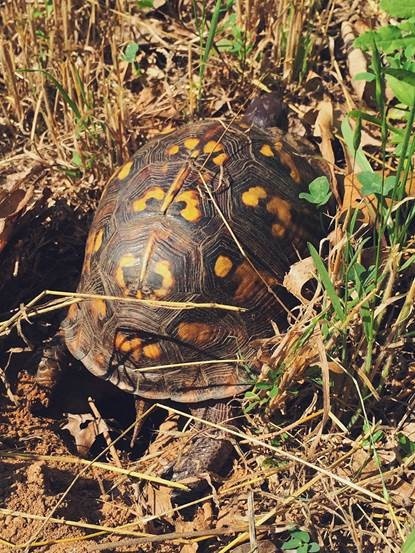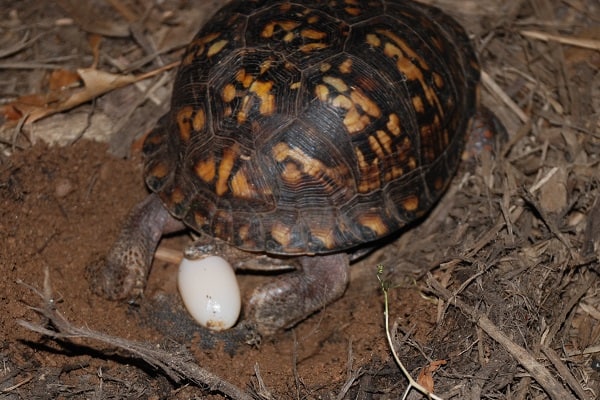What Does A Box Turtle Nest Look Like?
Box turtles are one of the most iconic species of turtles – they have unique shells and interesting habits. Box turtles are known for their nesting habits, and their nests are just as unique as their shells. Have you ever wondered what a box turtle nest looks like? In this article, we will explore the characteristics of a box turtle nest and what you can do to help protect this species. So, let’s dive in and learn about the fascinating world of box turtle nesting!
A box turtle nest is typically a shallow depression in the sand or soil, usually lined with leaves or grass. The nest is usually located in an open, sunny area. The female turtle will lay between two and eight eggs in the nest. The eggs are round and leathery in texture, and the female will cover them with dirt and leaves to protect them. The eggs will typically hatch after two to three months.

What Does a Box Turtle Nest Look Like?
Box turtles are a species of chelonian that is found in North America. Box turtles are known for their domed upper shells and hinged lower shells, which enable them to completely close off their body from the outside world. In addition to this unique adaptation, box turtles also have the ability to lay eggs in nests that are quite distinct from the nests of other species of turtles. In this article, we will explore what a box turtle nest looks like.
The Appearance of a Box Turtle Nest
The nests of box turtles are typically constructed in a shallow depression that the turtle has dug in the soil. The depression is usually no more than 4 inches deep and it is generally lined with dry leaves, grasses, and other organic material. The eggs are then laid in the center of the nest. It is important to note that box turtles do not cover the nest after they lay the eggs, so the eggs will remain exposed to the environment.
Size and Color of the Eggs
The eggs of box turtles are typically round or oval in shape and measure between 20 and 25 millimeters in length. The eggs are usually light tan in color but can range from white to a deep brown. It is also common to find small flecks of red or yellow on the eggs.
Incubation of the Eggs
Once the box turtle has laid her eggs in the nest, she will leave and it is up to the environment to incubate the eggs. The incubation period for box turtles typically lasts between 60 and 90 days, depending on the climate and soil conditions. During this period, the eggs will need to be kept moist in order to hatch successfully.
The Hatching Process
When the eggs are ready to hatch, the baby turtles will make their way to the surface of the nest. The hatchlings are usually about the size of a quarter and they have a soft, leathery shell. The hatchlings will typically remain in the nest for a few days before they start to explore their new environment.
Re-Burying the Nest
Once the hatchlings have left the nest, the female box turtle will return to the site and re-bury the nest. This is done to protect the eggs from predators and to ensure that they remain at a consistent temperature until they hatch. The female box turtle will also collect any remaining eggs that did not hatch and will re-bury them in the same area.
Signs of a Nest
When looking for a box turtle nest, there are a few signs that can help you identify it. The first is the presence of a shallow depression in the soil. This depression will usually be lined with dry, organic material such as leaves, grasses, and twigs. You may also find eggshells or hatchlings in the area.
The Benefits of a Nest
Box turtles are able to lay their eggs in nests that are well-protected from predators and the elements. This is beneficial for the species as it ensures that the eggs will have a greater chance of survival. In addition, the nests also provide a safe environment for the hatchlings to explore and learn about their new environment.
Protecting Box Turtle Nests
It is important to protect box turtle nests from human interference. If you come across a nest, it is best to leave it undisturbed and avoid walking or riding near it. If you must disturb the nest, it is important to cover it back up with the same material that was used to construct it.
Conclusion
Box turtles are a species of chelonian that is found in North America. Their nests are typically constructed in shallow depressions that are lined with dry leaves, grasses, and other organic material. The eggs are usually light tan in color and measure between 20 and 25 millimeters in length. Once laid, the eggs will need to be kept moist in order to hatch successfully. It is important to protect box turtle nests from human interference and to leave them undisturbed if possible.
Related Faq
What Does a Box Turtle Nest Look Like?
Answer:
A box turtle nest looks like a shallow indentation dug into the ground. It is usually about two inches deep and four inches wide, and is usually filled with decaying leaves, twigs, and other organic materials. The top of the nest is often covered with a thin layer of soil or other material. The nest is usually located in a secluded area, away from potential threats such as predators and harsh weather.
The eggs of the box turtle are usually laid in the same nesting site. The eggs are typically between one and two inches in diameter and are covered in a heavily textured, leathery shell. The eggs are usually laid in pairs and can take up to two weeks to hatch. Once the eggs are hatched, the baby turtles will typically emerge from the nest and make their way to nearby ponds and lakes to start their new lives.

Box Turtles Hatching and What to Expect
A box turtle nest is an amazing and unique sight to behold. It is a testament to the power of nature and the resilience of these animals. With its simple yet effective design, the box turtle nest is an integral part of the species’ survival. It provides a safe environment for the eggs to develop, and a secure place for the baby turtles to hide until they are ready to venture out into the world. From its hidden location to its distinctive layout, the box turtle nest is an important part of the natural environment.

